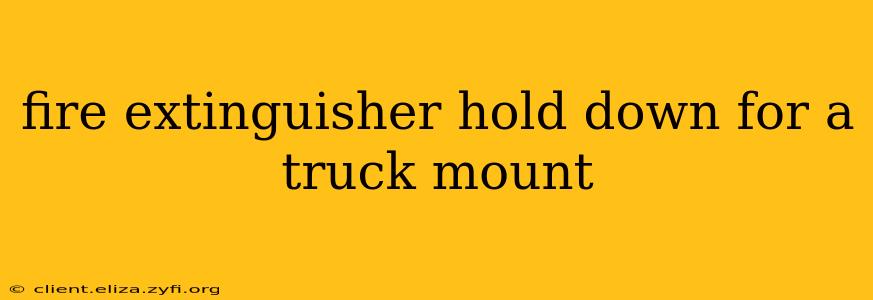Truck-mounted fire extinguishers are critical safety equipment, providing a rapid response capability in emergency situations. However, the dynamic nature of a moving vehicle necessitates secure mounting and reliable hold-downs to prevent extinguisher displacement during transit or in the event of an accident. This guide delves into the crucial aspects of fire extinguisher hold-downs for truck mounts, covering selection, installation, and maintenance.
What are the Different Types of Fire Extinguisher Hold Downs?
Several types of hold-downs cater to diverse truck configurations and extinguisher sizes. Common options include:
-
Strap-style hold-downs: These utilize heavy-duty straps secured around the extinguisher and bolted to the truck's mounting bracket. They offer flexibility and adaptability to different extinguisher sizes. Adjustability is key to ensuring a snug fit.
-
Bracket-style hold-downs: These employ a custom-fabricated bracket that directly mounts to the extinguisher and the truck bed. They often offer more rigidity and potentially a more secure hold than strap systems.
-
Universal mounts: Designed for broader compatibility with various extinguisher types and sizes, these systems utilize adjustable clamps or straps to secure the extinguisher.
The best type of hold-down will depend on factors such as the specific extinguisher model, the truck's make and model, and the mounting location.
How Do I Choose the Right Hold Down for My Fire Extinguisher?
Selecting the appropriate hold-down involves careful consideration of several critical factors:
-
Extinguisher size and weight: The hold-down must be rated to securely support the extinguisher's weight, even under extreme conditions. Never compromise on strength.
-
Truck mounting location: The chosen hold-down must be compatible with the available mounting points on your truck. Consider accessibility for inspection and maintenance.
-
Environmental conditions: The hold-down should be resistant to corrosion, extreme temperatures, and other environmental factors prevalent in your operating area. Stainless steel is often a preferred material for its durability.
-
Compliance with regulations: Ensure the hold-down meets all relevant safety standards and regulations for commercial vehicles. Consult local and national guidelines.
What are the Regulations and Standards for Fire Extinguisher Hold Downs?
Regulations surrounding fire extinguisher mounting vary depending on location and the type of vehicle. However, several common themes emerge:
-
Secure mounting: Hold-downs must securely prevent extinguisher movement during operation and in the event of an accident. This often involves specific weight and strength ratings.
-
Accessibility: Extinguishers must be readily accessible for use in an emergency. Obstructions or overly complex hold-downs should be avoided.
-
Visibility: The extinguisher and its mounting should be clearly visible to the driver and other occupants.
Always check with your local fire marshal or transportation authority for the most up-to-date regulations applicable in your area.
How Do I Properly Install a Fire Extinguisher Hold Down?
Installation should always be performed by a qualified technician familiar with the specific hold-down and truck mounting system. Improper installation can compromise safety. Generally, installation will involve:
-
Securing the mounting bracket: This usually involves bolting the bracket to the truck bed at pre-determined points.
-
Attaching the hold-down mechanism: The specific method will depend on the type of hold-down. This may involve tightening straps or securing brackets.
-
Mounting the extinguisher: Carefully place the extinguisher within the hold-down, ensuring it is snug but not overly compressed.
-
Inspection: Thoroughly inspect the entire assembly to verify its stability and proper functionality.
How Often Should I Inspect My Fire Extinguisher Hold Down?
Regular inspections are crucial for maintaining safety and preventing accidents. The frequency of inspection should align with your vehicle's maintenance schedule, but at minimum, a visual inspection should be conducted monthly. This visual inspection should check for signs of damage, corrosion, looseness, or wear and tear.
What Happens if My Fire Extinguisher Hold Down Fails?
Failure of a fire extinguisher hold-down can have serious consequences, ranging from minor inconvenience to significant damage or injury. In the event of a collision, an unsecured extinguisher could become a projectile, causing harm to vehicle occupants or other individuals. Regular maintenance and adherence to safety regulations are essential to mitigate this risk.
By diligently following these guidelines, you can ensure your truck-mounted fire extinguishers remain securely in place, ready for action when needed. Remember: safety should always be the top priority.
